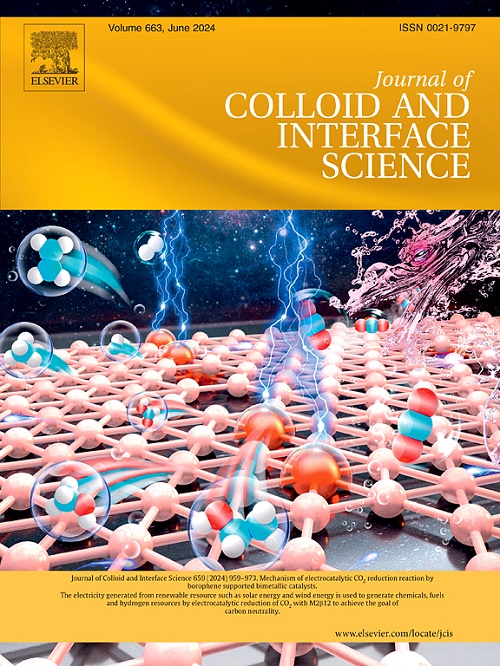界面超混沌纳米离子交联微凝胶:乳状液的可控稳定
IF 9.7
1区 化学
Q1 CHEMISTRY, PHYSICAL
引用次数: 0
摘要
假设聚n -异丙基丙烯酰胺(pNIPAM)微凝胶是一种软颗粒,它吸附在液体界面上,并赋予乳液抗聚结的稳定性。它们在界面上的构象和相互作用对界面的力学性能有很大影响。特别是,界面弹性模量随着微凝胶交联密度的降低而增加,这是微凝胶变形和与邻居纠缠的结果。这项工作的目的是研究如何通过超混沌凯金纳米离子(POMs)和pNIPAM微凝胶之间的物理相互作用来调节这些特征。实验研究了不同交联密度和尺寸的多金属氧酸盐(pom)和pNIPAM微凝胶在水悬浮液和液/液界面中的相互作用。微凝胶稳定水包油乳状液的能力通过评估其动力学稳定性和流动特性来评估,在乳化前或乳化后分别引入聚甲醛。低温电子显微镜(cryo-EM)用于直接观察微凝胶稳定乳状液。用振荡垂滴法研究了微凝胶在模型界面上的吸附和不同浓度POM对界面弹性的影响。发现spoms作为物理交联剂促进微凝胶溶胀。对于大的微凝胶,这种效应增加了它们的硬度。因此加入聚甲醛会降低乳剂的稳定性。相比之下,小的负载pom的微凝胶产生高度稳定的乳液,在机械应力或温度升高下抵抗聚结。乳化后加入聚甲醛的大微凝胶也是如此。事实上,pom通过促进颗粒内和颗粒间的界面交联来增强界面弹性。最后,通过连接相邻液滴表面之间的微凝胶单层,pom促进了液滴之间的粘附。皮克林乳剂中的所有层次的多尺度结构都是由POMs和pNIPAM之间的相互作用控制的。本文章由计算机程序翻译,如有差异,请以英文原文为准。

Inter cross-linking microgels by superchaotropic nano-ions at interface: Controlled stabilization of emulsions
Hypothesis
Poly(N-isopropylacrylamide) (pNIPAM) microgels are soft particles that adsorb at liquid interfaces and confer emulsion stability against coalescence. Their conformation and interactions at the interface greatly impact the mechanical properties of the interface. In particular, the interfacial elastic modulus increases as the microgel cross-linking density decreases, as a consequence of microgel ability to deform and entangle with neighbors. The purpose of this work is to investigate how these features can be tuned by physical interactions between superchaotropic Keggin nano-ions (POMs) and pNIPAM microgels.
Experiments
Interactions between polyoxometalates (POMs) and pNIPAM microgels of varying cross-linking densities and sizes are investigated in aqueous suspensions and at liquid/liquid interfaces. The ability of microgels to stabilize oil-in-water emulsions is assessed by evaluating their kinetic stability and flow characteristics, with POMs introduced either before or after emulsification. Cryogenic electron microscopy (cryo-EM) is employed to directly visualize the microgel-stabilized emulsions. The adsorption of microgels, at a model interface and the resulting interfacial elasticity with various POM concentrations, are also studied using the oscillating pendant drop method.
Findings
POMs act as physical cross-linkers that promotes microgel deswelling. For large microgels, this effect increases their stiffness. and thus adding POMs reduces the stability of the emulsions. In contrast, small POM-loaded microgels produce highly stable emulsions that resist coalescence under mechanical stress or temperature increase. The same is true for large microgels supplemented in POMs after emulsification. Indeed, POMs enhance interfacial elasticity by promoting both intra-particle and inter-particle crosslinking at the interface. Lastly, by connecting microgel monolayers between neighboring droplet surfaces, POMs promote adhesion between droplets. All levels of the multiscale structure within Pickering emulsions are controlled by interactions between POMs and pNIPAM.
求助全文
通过发布文献求助,成功后即可免费获取论文全文。
去求助
来源期刊
CiteScore
16.10
自引率
7.10%
发文量
2568
审稿时长
2 months
期刊介绍:
The Journal of Colloid and Interface Science publishes original research findings on the fundamental principles of colloid and interface science, as well as innovative applications in various fields. The criteria for publication include impact, quality, novelty, and originality.
Emphasis:
The journal emphasizes fundamental scientific innovation within the following categories:
A.Colloidal Materials and Nanomaterials
B.Soft Colloidal and Self-Assembly Systems
C.Adsorption, Catalysis, and Electrochemistry
D.Interfacial Processes, Capillarity, and Wetting
E.Biomaterials and Nanomedicine
F.Energy Conversion and Storage, and Environmental Technologies

 求助内容:
求助内容: 应助结果提醒方式:
应助结果提醒方式:


